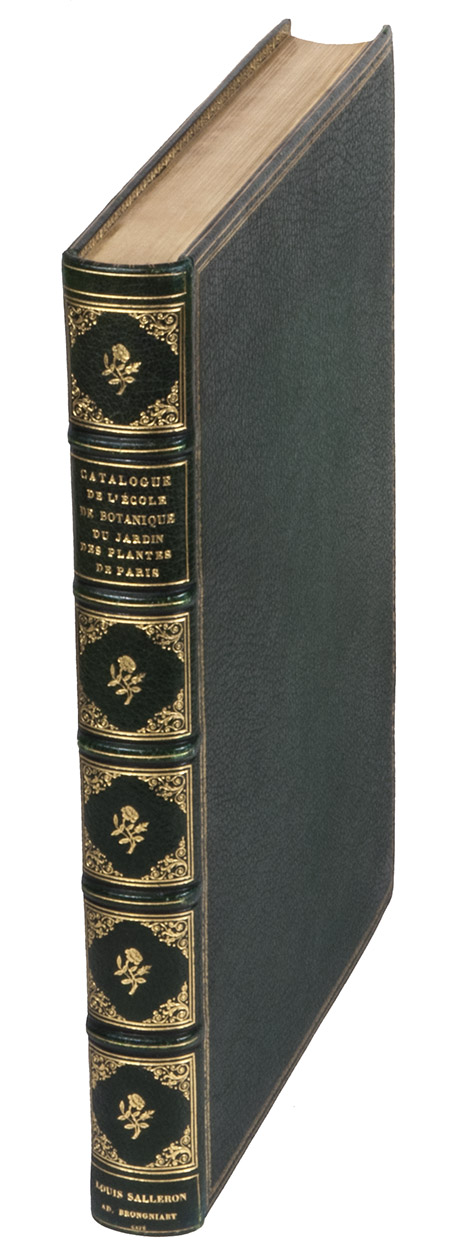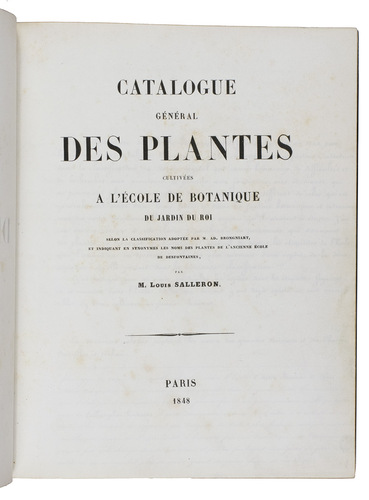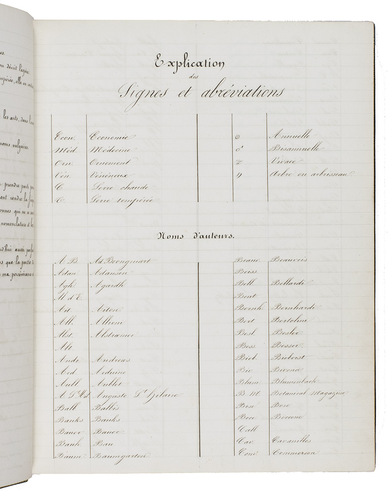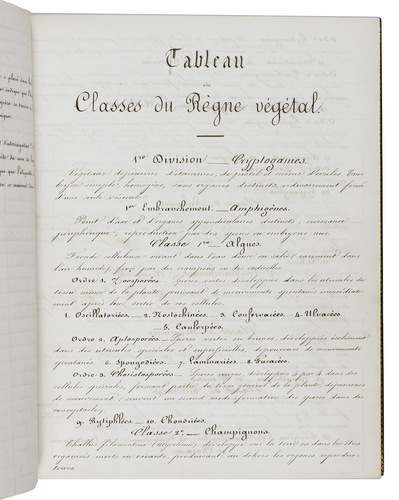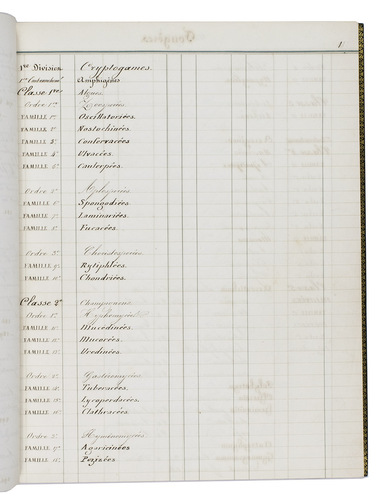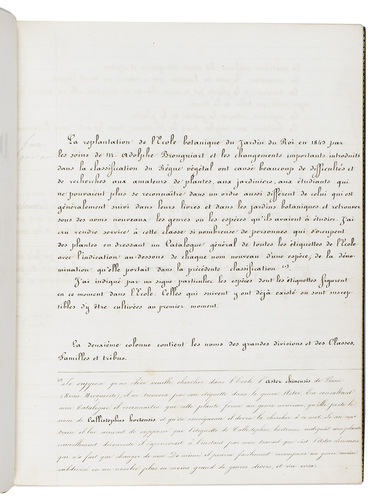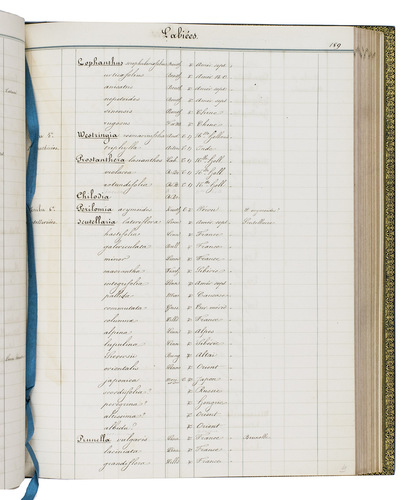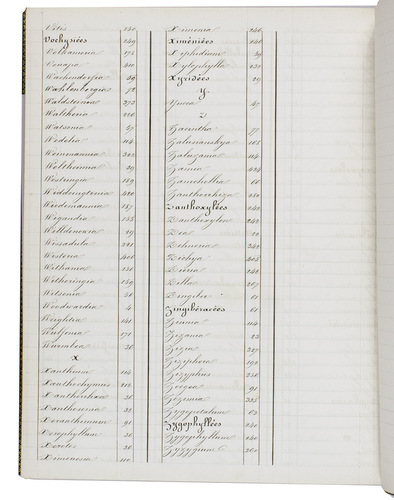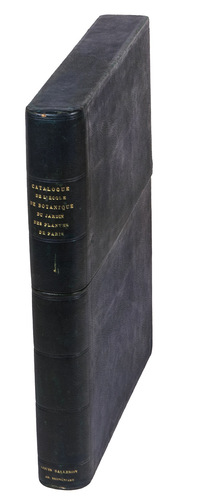SALLERON, Louis.
[MANUSCRIPT]. Catalogue général des plantes cultivées a l'école de botanique du jardin du roi. Selon la classification adoptée par M. Ad. Brongniart, et indiquant en synonymes les noms des plantes de l'ancienne école de desfontaines.
Paris, 1848. 4to. In a dark green custom case with thte title on the spine in gold lettering, interior of red calfskin lined with suede. Dark green morocco. [10], 17, [1], 425, [31] pp.
€ 28,000
Wonderful mid-nineteenth century French work on botanical classification. Louis Salleron describes the the purpose of his work as follows: "The replanting of the Botanical School of the Jardin du Roi in 1843 by the care of M Adolphe Brongniart and the important changes introduced in the classification of the Plant Kingdom caused many difficulties and research for plant lovers, gardeners, to students who could no longer recognize themselves in an order so different from that which is generally followed in their books and in botanical gardens [...]. I thought I was doing a service to this large class of people who deal with plants by drawing up a General Catalog of all the labels of the School, with the indication below each new name of a species, of the denomination it bore in the previous classification". Sallerons catalogue mentions several thousand plants, coming from France and abroad: California, Mexico, Virginia, Canada, West Indies, Brazil, Peru, Chile, Cape of Good Hope, India, Japan, China, Siberia, etc. The present manuscript, dated 1848, can be placed between the first edition of Brongniart's catalog, published in 1843, and the second edition of 1850. The Table of classes of the vegetable kingdom that it contains is a copy of Brongniart's work; however, Louis Salleron largely completed the work of the latter by providing, in the form of a table, additional information: "The second column contains the names of the major divisions and of the classes, families and tribes. The fourth contains the names of the genera and species. The fifth, the name of the author who named or described the species, The sixth, if the plant is hothouse or temperate [...]. The seventh indicates the homeland of the plant. The eighth, its use in medicine, in the arts, in the ornament of gardens or its poisonous properties. The ninth, its French name or its various vulgar names".
Salleron understood his catalogue as a practical guide through botanical classification. "I suppose that a pupil wants to look in the School for the Aster chinensis of Linné (Queen Marguerite), he will not find his label in the genus Aster. By consulting my catalogue, he will recognise that this plant forms a new genus, that it bears the name of Callistephus hortensis and that consequently he will have to look for it by this word. If, on the contrary, he happened to suppose that the label of Callistephus hortensis indicated a newly discovered plant, he would instantly perceive by my work that it is Aster chinensis which has only changed its name. ..". At the end of his foreword he concedes, that "[m]y work is probably not as perfect today as it can become with the help of time; I hope, however, that the part of the public for which it was made will be grateful to me for my perseverance and my efforts". It is possible that this manuscript was produced with the intention of being published.
Louis Salleron, of whom no biography is available, was probably a collaborator of Brongniart, whose name appears on the back of the binding and on the slipcase. Adolphe Brongniart (1801-1876) is a botanist considered the father of "palaeobotany". In 1833, he obtained the chair of Botany within the Natural History Museum of Paris. The School of Botany having been enlarged at the beginning of the 1840s, he had to renew the plantations during the winter of 1842-1843. On this occasion he published, in 1843, a catalogue entitled Enumération des genres de plantes cultivés au Muséum d'histoire naturelle de Paris, suivant l'ordre établi dans l'Ecole de botanique, followed the order established in the School of Botany (Paris, Fortin Masson), in which he presented a new system of classification of the vegetable kingdom. A second edition, revised and enlarged, was published in 1850 (Paris, J.-B. Baillière). Louis Salleron therefore took up this classification system by developing it with the indication of the species concerned and by providing important details on the plants.
The wonderful moroccan binding is the work of Charles-François Capé (1806-1867). His signature can be found on the spine. Established first at the Louvre where he worked for the library, he eventually became Empress's bookbinder and one of the greatest French bookbinders of his time.
Some very light tear to upper part of custom casing, pencil annotations to first flyleaves, light foxing to title page. Excellent condition.
Related Subjects:
